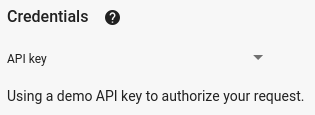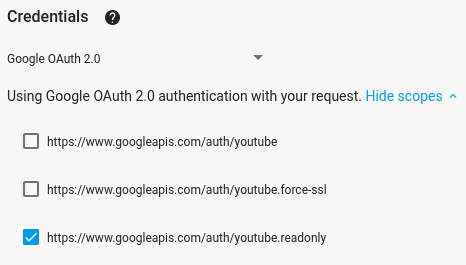Ce guide de démarrage rapide explique comment configurer une application de ligne de commande PHP simple qui envoie des requêtes à l'API YouTube Data. Ce guide de démarrage rapide explique comment effectuer deux requêtes API :
- Vous utiliserez une clé API, qui identifie votre application, pour récupérer des informations sur la chaîne YouTube GoogleDevelopers.
- Vous utiliserez un ID client OAuth 2.0 pour envoyer une requête autorisée qui récupère des informations sur votre propre chaîne YouTube.
Prérequis
Pour exécuter ce guide de démarrage rapide, vous avez besoin des éléments suivants :
- PHP 5.4 ou version ultérieure avec l'interface de ligne de commande (CLI) et l'extension JSON installées.
- L'outil de gestion des dépendances Composer installé globalement
- Bibliothèque cliente des API Google pour PHP :
- Si vous n'avez pas encore installé la bibliothèque cliente :
composer require google/apiclient:^2.0
- Si vous avez déjà installé la bibliothèque cliente, nous vous recommandons de la mettre à jour pour vous assurer de disposer des classes les plus récentes pour la bibliothèque que vous testez :
composer update google/apiclient --with-dependencies
- Si vous n'avez pas encore installé la bibliothèque cliente :
Étape 1 : Configurez votre projet et vos identifiants
Créez ou sélectionnez un projet dans la console APIs. Effectuez les tâches suivantes dans la console API pour votre projet :
Dans le panneau de la bibliothèque, recherchez l'API YouTube Data v3. Cliquez sur la fiche de cette API et assurez-vous qu'elle est activée pour votre projet.
Dans le panneau des identifiants, créez deux identifiants :
Créer une clé API Vous utiliserez la clé API pour effectuer des requêtes API qui ne nécessitent pas d'autorisation de l'utilisateur. Par exemple, vous n'avez pas besoin de l'autorisation de l'utilisateur pour récupérer des informations sur une chaîne YouTube publique.
Créez un ID client OAuth 2.0. Définissez le type d'application sur Autre. Vous devez utiliser des identifiants OAuth 2.0 pour les requêtes qui nécessitent une autorisation de l'utilisateur. Par exemple, vous avez besoin de l'autorisation de l'utilisateur pour récupérer des informations sur la chaîne YouTube de l'utilisateur actuellement authentifié.
Téléchargez le fichier JSON contenant vos identifiants OAuth 2.0. Le fichier porte un nom tel que
client_secret_CLIENTID.json, oùCLIENTIDest l'ID client de votre projet.
Étape 2 : Configurer et exécuter l'exemple
Utilisez le widget APIs Explorer dans le panneau latéral pour obtenir un exemple de code permettant de récupérer des informations sur la chaîne YouTube GoogleDevelopers. Cette requête utilise une clé API pour identifier votre application. Elle ne nécessite pas d'autorisation de l'utilisateur ni d'autorisations spéciales de la part de l'utilisateur qui exécute l'exemple.
- Ouvrez la documentation de la méthode channels.list de l'API.
Sur cette page, la section "Cas d'utilisation courants" contient un tableau qui explique plusieurs façons courantes d'utiliser la méthode. La première ligne du tableau concerne les résultats de la liste par ID de chaîne.
Cliquez sur le symbole de code de la première fiche pour ouvrir et remplir l'explorateur d'API en plein écran.

La partie gauche de l'explorateur d'API en plein écran affiche les éléments suivants :
Sous l'en-tête Paramètres de la requête, vous trouverez la liste des paramètres acceptés par la méthode. Les valeurs des paramètres
partetiddoivent être définies. La valeur du paramètreid,UC_x5XG1OV2P6uZZ5FSM9Ttw, correspond à l'ID de la chaîne YouTube GoogleDevelopers.Sous les paramètres, vous trouverez une section intitulée Identifiants. Le menu déroulant de cette section doit afficher la valeur Clé API. L'explorateur d'API utilise des identifiants de démonstration par défaut pour vous aider à vous lancer. Toutefois, vous utiliserez votre propre clé API pour exécuter l'exemple en local.

Sur la droite de l'explorateur d'API en plein écran, des onglets affichent des exemples de code dans différentes langues. Sélectionnez l'onglet PHP.
Copiez l'exemple de code et enregistrez-le dans un fichier nommé
example.php.Dans l'exemple que vous avez téléchargé, recherchez la chaîne
YOUR_API_KEYet remplacez-la par la clé API que vous avez créée à l'étape 1 de ce guide de démarrage rapide.Exécutez l'exemple à partir de la ligne de commande. Dans votre répertoire de travail, exécutez la commande suivante :
php example.phpL'exemple doit exécuter la requête et imprimer la réponse dans
STDOUT.
Étape 3 : Exécutez une requête autorisée
Dans cette étape, vous allez modifier l'exemple de code afin qu'au lieu de récupérer des informations sur la chaîne YouTube GoogleDevelopers, il récupère des informations sur votre chaîne YouTube. Cette requête nécessite l'autorisation de l'utilisateur.
Revenez à la documentation de la méthode channels.list de l'API.
Dans la section "Cas d'utilisation courants", cliquez sur le symbole de code de la troisième ligne du tableau. Dans ce cas d'utilisation, il s'agit d'appeler la méthode
listpour "ma chaîne".Une fois encore, sur la gauche de l'écran complet d'APIs Explorer, vous verrez une liste de paramètres suivie de la section Identifiants. Toutefois, deux modifications ont été apportées par rapport à l'exemple dans lequel vous avez récupéré des informations sur la chaîne GoogleDevelopers :
Dans la section des paramètres, au lieu de définir la valeur du paramètre
id, définissez la valeur du paramètreminesurtrue. Cette instruction demande au serveur d'API de récupérer des informations sur la chaîne de l'utilisateur actuellement authentifié.Dans la section Identifiants, le menu déroulant doit sélectionner l'option Google OAuth 2.0.
De plus, si vous cliquez sur le lien Afficher les champs d'application, le champ d'application https://www.googleapis.com/auth/youtube.readonly doit être coché.

Comme dans l'exemple précédent, sélectionnez l'onglet PHP, copiez l'exemple de code et enregistrez-le dans
example.php.Dans le code, recherchez la chaîne
YOUR_CLIENT_SECRET_FILE.jsonet remplacez-la par l'emplacement du fichier de code secret du client que vous avez téléchargé à l'étape 1 de ce guide de démarrage rapide.Exécutez l'exemple à partir de la ligne de commande. Dans votre répertoire de travail, exécutez la commande suivante :
php example.php-
Copiez l'URL depuis la console et ouvrez-la dans votre navigateur.
Si vous n'êtes pas encore connecté à votre compte Google, vous serez invité à le faire. Si vous êtes connecté à plusieurs comptes Google, vous serez invité à en sélectionner un pour l'autorisation.
Cliquez sur le bouton pour accorder à votre application l'accès aux niveaux d'accès spécifiés dans votre exemple de code.
-
Copiez le code d'authentification depuis le navigateur et collez-le dans votre terminal. Vous pouvez ensuite fermer l'onglet du navigateur utilisé pour le flux d'authentification.
La réponse de l'API doit à nouveau être imprimée dans
STDOUT.
Documentation complémentaire
- Documentation d'aide de la Google Developers Console
- Documentation de la bibliothèque cliente des API Google pour PHP
- La bibliothèque cliente des API Google pour PHP sur GitHub et les classes générées automatiquement pour l'API YouTube. (Sur la page, recherchez le dossier
YouTubeet le fichierYouTube.php. - Documentation de référence de l'API YouTube Data
